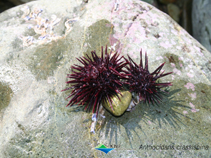Heliocidaris crassispina (Agassiz, 1864)
Purple sea urchin
Classification / Names Common names | Synonyms | CoL | ITIS | WoRMS
Echinoidea | Camarodonta | Echinometridae
Environment: milieu / climate zone / depth range / distribution range Ecology
Benthic; depth range 0 - 70 m (Ref. 81020). Tropical
Distribution Countries | FAO areas | Ecosystems | Occurrences | Introductions
Northwest Pacific: Hong Kong.
Length at first maturity / Size / Weight / Age
Maturity: Lm ? range ? - ? cm Max length : 7.7 cm WD male/unsexed; (Ref. 126588); max. reported age: 11 years (Ref. 126586)
Found on shallow waters (<5 meters), in intertidal pools (Ref. 124789) with rocky substrate (Ref. 119717). Occur on both sheltered and exposed shores. Clustered in rock crevices, or at the base and undersides of boulders. Aggregation suggests adaptive behavior to wave turbulence (Ref. 127097). An opportunistic feeder, but feeds mainly on algae (Ref. 125532).
Life cycle and mating behavior Maturity | Reproduction | Spawning | Eggs | Fecundity | Larvae
Members of the class Echinoidea are gonochoric. Fertilization is external. Brooding is common, eggs are held either on the peristome, around the periproct or deep into the concavities on the petaloids. Life cycle: Embryos develop into planktotrophic larvae (echinoplateus) and live for several months before they sink to the bottom using their tube feet to adhere on the ground where they metamorphose into young urchins.
Main reference
References | Coordinator | Collaborators
Chiu, S.T. 1990. (Ref. 85020)
IUCN Red List Status (Ref. 130435)
CITES status (Ref. 108899)
Not Evaluated
CMS (Ref. 116361)
Not Evaluated
Threat to humans
Human uses
| FishSource |
Tools
More information
Internet sources
BHL | BOLD Systems | CISTI | DiscoverLife | FAO(Publication : search) | Fishipedia | GenBank (genome, nucleotide) | GloBI | Gomexsi | Google Books | Google Scholar | Google | PubMed | Tree of Life | Wikipedia (Go, Search) | Zoological Record
Estimates based on models
Price category
(Ref. 80766):
Unknown.



